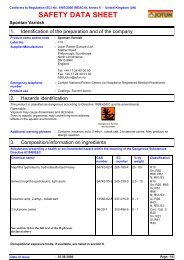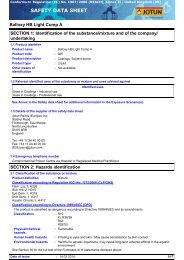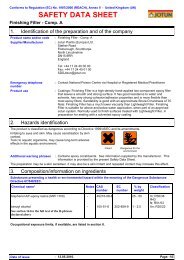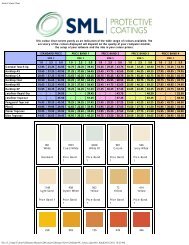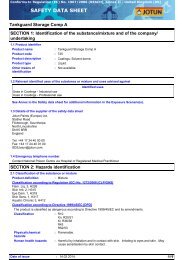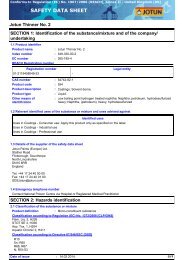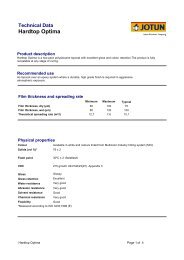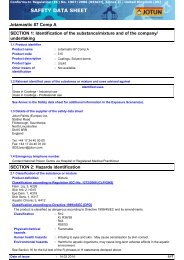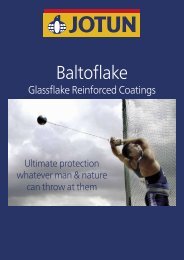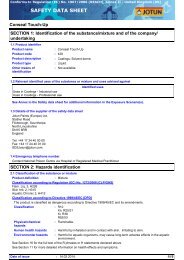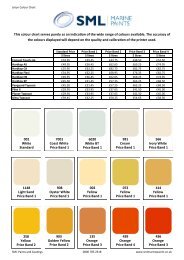Safety data sheet for SeaForce 30 (UK) - English (uk)
Safety data sheet for SeaForce 30 (UK) - English (uk)
Safety data sheet for SeaForce 30 (UK) - English (uk)
- No tags were found...
You also want an ePaper? Increase the reach of your titles
YUMPU automatically turns print PDFs into web optimized ePapers that Google loves.
Con<strong>for</strong>ms to Regulation (EC) No. 1907/2006 (REACH), Annex II - United Kingdom (<strong>UK</strong>)SAFETY DATA SHEET<strong>SeaForce</strong> <strong>30</strong> (<strong>UK</strong>)SECTION 1: Identification of the substance/mixture and of the company/undertaking1.1 Product identifierProduct name :Product code :Product description :Product type :Other means ofidentificationRestrictions ::<strong>SeaForce</strong> <strong>30</strong> (<strong>UK</strong>)3860Coatings: Antifouling.Solvent-borne.Liquid.Not available.Only valid <strong>for</strong> <strong>UK</strong>.1.2 Relevant identified uses of the substance or mixture and uses advised againstUses in Coatings - Industrial useIdentified usesIndustrial applications, Used by spraying.1.3 Details of the supplier of the safety <strong>data</strong> <strong>sheet</strong>Jotun Paints (Europe) Ltd.Stather RoadFlixborough, ScunthorpeNorth LincolnshireDN15 8RREnglandTel: +44 17 24 40 00 00Fax: +44 17 24 40 01 00SDSJotun@jotun.com1.4 Emergency telephone numberContact National Poison Centre via Hospital or Registered Medical PractitionerSECTION 2: Hazards identification2.1 Classification of the substance or mixtureProduct definitionClassification according to Regulation (EC) No. 1272/2008 [CLP/GHS]Flam. Liq. 3, H226Acute Tox. 4, H<strong>30</strong>2Skin Irrit. 2, H315Skin Sens. 1, H317Aquatic Acute 1, H400Aquatic Chronic 1, H410The product is classified as dangerous according to Directive 1999/45/EC and its amendments.Classification: R10Xn; R20/21/22Xi; R38R43N; R50/53Physical/chemicalhazardsHuman health hazards: MixtureClassification according to Directive 1999/45/EC [DPD]: Flammable.:Harmful by inhalation, in contact with skin and if swallowed. Irritating to skin. Maycause sensitisation by skin contact.Date of issue : 25.02.2014.1/15
Con<strong>for</strong>ms to Regulation (EC) No. 1907/2006 (REACH), Annex II - United Kingdom (<strong>UK</strong>)<strong>SeaForce</strong> <strong>30</strong> (<strong>UK</strong>)SECTION 6: Accidental release measures6.1 Personal precautions, protective equipment and emergency proceduresFor non-emergencypersonnelFor emergency responders ::No action shall be taken involving any personal risk or without suitable training.Evacuate surrounding areas. Keep unnecessary and unprotected personnel fromentering. Do not touch or walk through spilt material. Shut off all ignition sources.No flares, smoking or flames in hazard area. Avoid breathing vapour or mist.Provide adequate ventilation. Wear appropriate respirator when ventilation isinadequate. Put on appropriate personal protective equipment.If specialised clothing is required to deal with the spillage, take note of anyin<strong>for</strong>mation in Section 8 on suitable and unsuitable materials. See also thein<strong>for</strong>mation in "For non-emergency personnel".6.2 Environmentalprecautions:Avoid dispersal of spilt material and runoff and contact with soil, waterways, drainsand sewers. In<strong>for</strong>m the relevant authorities if the product has caused environmentalpollution (sewers, waterways, soil or air). Water polluting material. May be harmfulto the environment if released in large quantities. Collect spillage.6.3 Methods and materials <strong>for</strong> containment and cleaning upSmall spill :Large spill :Stop leak if without risk. Move containers from spill area. Use spark-proof tools andexplosion-proof equipment. Dilute with water and mop up if water-soluble.Alternatively, or if water-insoluble, absorb with an inert dry material and place in anappropriate waste disposal container. Dispose of via a licensed waste disposalcontractor.Stop leak if without risk. Move containers from spill area. Use spark-proof tools andexplosion-proof equipment. Approach the release from upwind. Prevent entry intosewers, water courses, basements or confined areas. Wash spillages into aneffluent treatment plant or proceed as follows. Contain and collect spillage with noncombustible,absorbent material e.g. sand, earth, vermiculite or diatomaceous earthand place in container <strong>for</strong> disposal according to local regulations. Dispose of via alicensed waste disposal contractor. Contaminated absorbent material may pose thesame hazard as the spilt product.6.4 Reference to othersections:See Section 1 <strong>for</strong> emergency contact in<strong>for</strong>mation.See Section 8 <strong>for</strong> in<strong>for</strong>mation on appropriate personal protective equipment.See Section 13 <strong>for</strong> additional waste treatment in<strong>for</strong>mation.SECTION 7: Handling and storageThe in<strong>for</strong>mation in this section contains generic advice and guidance. The list of Identified Uses in Section 1 should beconsulted <strong>for</strong> any available use-specific in<strong>for</strong>mation provided in the Exposure Scenario(s).7.1 Precautions <strong>for</strong> safe handlingPrevent the creation of flammable or explosive concentrations of vapours in air and avoid vapour concentrations higherthan the occupational exposure limits.In addition, the product should only be used in areas from which all naked lights and other sources of ignition havebeen excluded. Electrical equipment should be protected to the appropriate standard.Mixture may charge electrostatically: always use earthing leads when transferring from one container to another.Operators should wear antistatic footwear and clothing and floors should be of the conducting type.Keep away from heat, sparks and flame. No sparking tools should be used.Avoid contact with skin and eyes. Avoid the inhalation of dust, particulates, spray or mist arising from the application ofthis mixture. Avoid inhalation of dust from sanding.Eating, drinking and smoking should be prohibited in areas where this material is handled, stored and processed.Put on appropriate personal protective equipment (see Section 8).Never use pressure to empty. Container is not a pressure vessel.Always keep in containers made from the same material as the original one.Comply with the health and safety at work laws.Do not allow to enter drains or watercourses.In<strong>for</strong>mation on fire and explosion protectionVapours are heavier than air and may spread along floors. Vapours may <strong>for</strong>m explosive mixtures with air.When operators, whether spraying or not, have to work inside the spray booth, ventilation is unlikely to be sufficient tocontrol particulates and solvent vapour in all cases. In such circumstances they should wear a compressed air-fedrespirator during the spraying process and until such time as the particulates and solvent vapour concentration hasfallen below the exposure limits.Date of issue : 25.02.2014.5/15
Con<strong>for</strong>ms to Regulation (EC) No. 1907/2006 (REACH), Annex II - United Kingdom (<strong>UK</strong>)<strong>SeaForce</strong> <strong>30</strong> (<strong>UK</strong>)SECTION 7: Handling and storage7.2 Conditions <strong>for</strong> safe storage, including any incompatibilitiesStore in accordance with local regulations.Notes on joint storageKeep away from: oxidising agents, strong alkalis, strong acids.Additional in<strong>for</strong>mation on storage conditionsObserve label precautions. Store in a dry, cool and well-ventilated area. Keep away from heat and direct sunlight. Keepaway from sources of ignition. No smoking. Prevent unauthorised access. Containers that have been opened must becarefully resealed and kept upright to prevent leakage.7.3 Specific end use(s)Recommendations :Industrial sector specificsolutions:Not available.Not available.SECTION 8: Exposure controls/personal protectionThe in<strong>for</strong>mation in this section contains generic advice and guidance. The list of Identified Uses in Section 1 should beconsulted <strong>for</strong> any available use-specific in<strong>for</strong>mation provided in the Exposure Scenario(s).8.1 Control parametersOccupational exposure limitsxylenerosinethylbenzeneProduct/ingredient name1-methoxy-2-propanolSolvent naphtha (petroleum), light arom.Recommended monitoringprocedures:Exposure limit valuesEH40/2005 WELs (United Kingdom (<strong>UK</strong>), 12/2011). Absorbedthrough skin.STEL: 441 mg/m³ 15 minutes.STEL: 100 ppm 15 minutes.TWA: 220 mg/m³ 8 hours.TWA: 50 ppm 8 hours.EH40/2005 WELs (United Kingdom (<strong>UK</strong>), 12/2011). Skinsensitiser.STEL: 0,15 mg/m³ 15 minutes. Form: FumeTWA: 0,05 mg/m³ 8 hours. Form: FumeEH40/2005 WELs (United Kingdom (<strong>UK</strong>), 12/2011). Absorbedthrough skin.STEL: 552 mg/m³ 15 minutes.STEL: 125 ppm 15 minutes.TWA: 100 ppm 8 hours.TWA: 441 mg/m³ 8 hours.EH40/2005 WELs (United Kingdom (<strong>UK</strong>), 12/2011). Absorbedthrough skin.STEL: 560 mg/m³ 15 minutes.STEL: 150 ppm 15 minutes.TWA: 375 mg/m³ 8 hours.TWA: 100 ppm 8 hours.EH40-WEL (United Kingdom (<strong>UK</strong>), 12/2011). Absorbed throughskin.TWA: 200 mg/m³ 8 hours. Form: All <strong>for</strong>msTWA: 40 ppm 8 hours. Form: All <strong>for</strong>msIf this product contains ingredients with exposure limits, personal, workplaceatmosphere or biological monitoring may be required to determine the effectivenessof the ventilation or other control measures and/or the necessity to use respiratoryprotective equipment. Reference should be made to monitoring standards, such asthe following: European Standard EN 689 (Workplace atmospheres - Guidance <strong>for</strong>the assessment of exposure by inhalation to chemical agents <strong>for</strong> comparison withlimit values and measurement strategy) European Standard EN 14042 (Workplaceatmospheres - Guide <strong>for</strong> the application and use of procedures <strong>for</strong> the assessmentof exposure to chemical and biological agents) European Standard EN 482(Workplace atmospheres - General requirements <strong>for</strong> the per<strong>for</strong>mance of procedures<strong>for</strong> the measurement of chemical agents) Reference to national guidanceDate of issue : 25.02.2014.6/15
Con<strong>for</strong>ms to Regulation (EC) No. 1907/2006 (REACH), Annex II - United Kingdom (<strong>UK</strong>)<strong>SeaForce</strong> <strong>30</strong> (<strong>UK</strong>)SECTION 8: Exposure controls/personal protectionDerived no effect levelsdocuments <strong>for</strong> methods <strong>for</strong> the determination of hazardous substances will also berequired.Product/ingredient name Type Exposure Value Population Effectsxylene DNEL Short term 289 mg/m³ Workers SystemicInhalationDNEL Short term 289 mg/m³ Workers LocalInhalationDNEL Long term Dermal 180 mg/kg Workers Systemicbw/dayDNEL Long term 77 mg/m³ Workers SystemicInhalationDNEL Long term Dermal 108 mg/kg Consumers Systemicbw/dayDNEL Long term 14,8 mg/m³ Consumers SystemicInhalationDNEL Long term Oral 1,6 mg/kg Consumers Systemicbw/dayrosin DNEL Long term Dermal 25 mg/kg Workers Systemicbw/dayDNEL Long term 176 mg/m³ Workers SystemicInhalationDNEL Long term Dermal 15 mg/kg Consumers Systemicbw/dayDNEL Long term 52 mg/m³ Consumers SystemicInhalationDNEL Long term Oral 15 mg/kg Consumers Systemicbw/dayzinc oxide DNEL Long term Dermal 83 mg/kg Workers Systemicbw/dayDNEL Long term 5 mg/m³ Workers SystemicInhalationDNEL Long term Dermal 83 mg/kg Consumers Systemicbw/dayDNEL Long term 2,5 mg/m³ Consumers SystemicInhalationDNEL Long term Oral 0,83 mg/ Consumers Systemickg bw/dayethylbenzene DNEL Short term 293 mg/m³ Workers LocalInhalationDNEL Long term Dermal 180 mg/kg Workers Systemicbw/dayDNEL Long term 77 mg/m³ Workers SystemicInhalationDNEL Long term 15 mg/m³ Consumers SystemicInhalationDNEL Long term Oral 1,6 mg/kg Consumers Systemicbw/day1-methoxy-2-propanol DNEL Short term 553,5 mg/ Workers LocalInhalation m³DNEL Long term Dermal 50,6 mg/ Workers Systemickg bw/dayDNEL Long term 369 mg/m³ Workers SystemicInhalationDNEL Long term Dermal 18,1 mg/ Consumers Systemickg bw/dayDNEL Long term 43,9 mg/m³ Consumers SystemicInhalationDNEL Long term Oral 3,3 mg/kg Consumers Systemicbw/daySolvent naphtha (petroleum), light DNEL Long term Dermal 25 mg/kg Workers Systemicarom.bw/dayDNEL Long term 150 mg/m³ Workers SystemicInhalationDNEL Long term Dermal 11 mg/kg Consumers SystemicDate of issue : 25.02.2014.7/15
Con<strong>for</strong>ms to Regulation (EC) No. 1907/2006 (REACH), Annex II - United Kingdom (<strong>UK</strong>)<strong>SeaForce</strong> <strong>30</strong> (<strong>UK</strong>)SECTION 8: Exposure controls/personal protectionPredicted no effect concentrationsbw/dayDNEL Long term 32 mg/m³ Consumers SystemicInhalationDNEL Long term Oral 11 mg/kgbw/dayConsumers SystemicProduct/ingredient name Type Compartment Detail Value Method Detaildicopper oxide PNEC Fresh water 7,8 μg/l -PNEC Marine 5,2 μg/l -PNEC Sewage Treatment 2<strong>30</strong> μg/l -PlantPNEC Fresh water sediment 87 mg/kg dwt -PNEC Marine water sediment 676 mg/kg dwt -PNEC Soil 65 mg/kg dwt -xylene PNEC Fresh water 0,327 mg/l -PNEC Marine 0,327 mg/l -PNEC Sewage Treatment 6,58 mg/l -PlantPNEC Fresh water sediment 12,46 mg/kg dwt -PNEC Marine water sediment 12,46 mg/kg dwt -PNEC Soil 2,31 mg/kg dwt -rosin PNEC Fresh water 0,0054 mg/l -PNEC Marine 0,00054 mg/l -PNEC Sewage Treatment 1000 mg/l -PlantPNEC Fresh water sediment 0,02 mg/kg dwt -PNEC Marine water sediment 0,002 mg/kg dwt -PNEC Soil 0,0015 mg/kg dwt -zinc oxide PNEC Fresh water 20,6 μg/l -PNEC Marine 6,1 μg/l -PNEC Sewage Treatment 52 μg/l -PlantPNEC Fresh water sediment 117,8 mg/kg dwt -PNEC Marine water sediment 56,5 mg/kg dwt -PNEC Soil 35,6 mg/kg dwt -ethylbenzene PNEC Fresh water 0,1 mg/l -PNEC Marine 0,01 mg/l -PNEC Sewage Treatment 9,6 mg/l -PlantPNEC Fresh water sediment 13,7 mg/kg dwt -PNEC Soil 2,68 mg/kg dwt -PNEC Secondary Poisoning 20 mg/kg -1-methoxy-2-propanol PNEC Fresh water 10 mg/l -PNEC Marine 1 mg/l -PNEC Sewage Treatment 100 mg/l -PlantPNEC Fresh water sediment 52,3 mg/kg dwt -PNEC Marine water sediment 5,2 mg/kg dwt -PNEC Soil 5,49 mg/kg dwt -8.2 Exposure controlsAppropriate engineeringcontrolsIndividual protection measuresHygiene measures :: Use only with adequate ventilation. Use process enclosures, local exhaustventilation or other engineering controls to keep worker exposure to airbornecontaminants below any recommended or statutory limits. The engineeringcontrols also need to keep gas, vapour or dust concentrations below any lowerexplosive limits. Use explosion-proof ventilation equipment.Wash hands, <strong>for</strong>earms and face thoroughly after handling chemical products,be<strong>for</strong>e eating, smoking and using the lavatory and at the end of the working period.Appropriate techniques should be used to remove potentially contaminated clothing.Contaminated work clothing should not be allowed out of the workplace. Washcontaminated clothing be<strong>for</strong>e reusing. Ensure that eyewash stations and safetyshowers are close to the workstation location.Date of issue : 25.02.2014.8/15
Con<strong>for</strong>ms to Regulation (EC) No. 1907/2006 (REACH), Annex II - United Kingdom (<strong>UK</strong>)<strong>SeaForce</strong> <strong>30</strong> (<strong>UK</strong>)SECTION 8: Exposure controls/personal protectionEye/face protectionSkin protectionHand protectionBody protection :Other skin protectionRespiratory protection :Environmental exposurecontrols:::<strong>Safety</strong> eyewear complying with an approved standard should be used when a riskassessment indicates this is necessary to avoid exposure to liquid splashes, mists,gases or dusts. If contact is possible, the following protection should be worn,unless the assessment indicates a higher degree of protection: chemical splashgoggles.There is no one glove material or combination of materials that will give unlimitedresistance to any individual or combination of chemicals.The breakthrough time must be greater than the end use time of the product.The instructions and in<strong>for</strong>mation provided by the glove manufacturer on use,storage, maintenance and replacement must be followed.Gloves should be replaced regularly and if there is any sign of damage to the glovematerial.Always ensure that gloves are free from defects and that they are stored and usedcorrectly.The per<strong>for</strong>mance or effectiveness of the glove may be reduced by physical/chemical damage and poor maintenance.Barrier creams may help to protect the exposed areas of the skin but should not beapplied once exposure has occurred.For right choice of glove materials, with focus on chemical resistance and time ofpenetration, seek advice by the supplier of chemical resistant gloves.The user must check that the final choice of type of glove selected <strong>for</strong> handling thisproduct is the most appropriate and takes into account the particular conditions ofuse, as included in the user's risk assessment.Personal protective equipment <strong>for</strong> the body should be selected based on the taskbeing per<strong>for</strong>med and the risks involved and should be approved by a specialistbe<strong>for</strong>e handling this product. When there is a risk of ignition from static electricity,wear anti-static protective clothing. For the greatest protection from staticdischarges, clothing should include anti-static overalls, boots and gloves. Refer toEuropean Standard EN 1149 <strong>for</strong> further in<strong>for</strong>mation on material and designrequirements and test methods.Appropriate footwear and any additional skin protection measures should beselected based on the task being per<strong>for</strong>med and the risks involved and should beapproved by a specialist be<strong>for</strong>e handling this product.If workers are exposed to concentrations above the exposure limit, they must useappropriate, certified respirators. Use respiratory mask with charcoal and dust filterwhen spraying this product.(as filter combination A2-P2). In confined spaces, usecompressed-air or fresh-air respiratory equipment. When use of roller or brush,consider use of charcoalfilter.: Emissions from ventilation or work process equipment should be checked toensure they comply with the requirements of environmental protection legislation.In some cases, fume scrubbers, filters or engineering modifications to the processequipment will be necessary to reduce emissions to acceptable levels.SECTION 9: Physical and chemical properties9.1 In<strong>for</strong>mation on basic physical and chemical propertiesAppearancePhysical stateColourOdourOdour thresholdpHMelting point/freezing pointInitial boiling point andboiling rangeEvaporation rateLiquid.Various colours.Characteristic.Not available.Not available.Not available.Not available.Flash point : Closed cup: 25°CFlammability (solid, gas)::::::::Not available.: Not available.Date of issue : 25.02.2014.9/15
Con<strong>for</strong>ms to Regulation (EC) No. 1907/2006 (REACH), Annex II - United Kingdom (<strong>UK</strong>)<strong>SeaForce</strong> <strong>30</strong> (<strong>UK</strong>)SECTION 9: Physical and chemical propertiesBurning timeBurning rateUpper/lower flammability orexplosive limitsVapour pressureVapour densityRelative densitySolubility(ies)Partition coefficient: n-octanol/waterAuto-ignition temperatureDecomposition temperatureViscosityExplosive propertiesOxidising properties ::::: Highest known value: 1.2 kPa (9.3 mm Hg) (at 20°C) (ethylbenzene). Weightedaverage: 0.83 kPa (6.23 mm Hg) (at 20°C): Highest known value: 3.7 (Air = 1) (xylene). Weighted average: 3.64 (Air = 1)::::::Not applicable.Not applicable.1.1 - 13.1%1.67 g/cm³Insoluble in the following materials: cold water and hot water.Not available.Not available.: Not available.Not applicable.Not available.Not available.9.2 Other in<strong>for</strong>mationNo additional in<strong>for</strong>mation.SECTION 10: Stability and reactivity10.1 Reactivity : No specific test <strong>data</strong> related to reactivity available <strong>for</strong> this product or its ingredients.10.2 Chemical stability10.3 Possibility ofhazardous reactions:The product is stable.: Under normal conditions of storage and use, hazardous reactions will not occur.10.4 Conditions to avoid10.5 Incompatible materials::Avoid all possible sources of ignition (spark or flame). Do not pressurise, cut, weld,braze, solder, drill, grind or expose containers to heat or sources of ignition.Reactive or incompatible with the following materials:oxidizing materials10.6 Hazardousdecomposition products: Under normal conditions of storage and use, hazardous decomposition productsshould not be produced.SECTION 11: Toxicological in<strong>for</strong>mation11.1 In<strong>for</strong>mation on toxicological effectsThere are no <strong>data</strong> available on the mixture itself. The mixture has been assessed following the conventional method ofthe Dangerous Preparations Directive 1999/45/EC and classified <strong>for</strong> toxicological hazards accordingly. See Sections 2and 15 <strong>for</strong> details.Exposure to component solvent vapour concentrations in excess of the stated occupational exposure limit may result inadverse health effects such as mucous membrane and respiratory system irritation and adverse effects on the kidneys,liver and central nervous system. Solvents may cause some of the above effects by absorption through the skin.Symptoms and signs include headache, dizziness, fatigue, muscular weakness, drowsiness and, in extreme cases,loss of consciousness. Repeated or prolonged contact with the mixture may cause removal of natural fat from the skin,resulting in non-allergic contact dermatitis and absorption through the skin. If splashed in the eyes, the liquid maycause irritation and reversible damage. Swallowing may cause nausea, diarrhoea, vomiting, gastro-intestinal irritationand chemical pneumonia.Contains rosin, zineb. May produce an allergic reaction.Date of issue : 25.02.2014.10/15
Con<strong>for</strong>ms to Regulation (EC) No. 1907/2006 (REACH), Annex II - United Kingdom (<strong>UK</strong>)<strong>SeaForce</strong> <strong>30</strong> (<strong>UK</strong>)SECTION 11: Toxicological in<strong>for</strong>mationProduct/ingredient name Result Species Dose Exposuredicopper oxide LD50 Oral Rat 470 mg/kg -LD50 Oral Rat 470 mg/kg -xylene LC50 Inhalation Gas. Rat 6700 ppm 4 hoursLD50 Oral Rat 4<strong>30</strong>0 mg/kg -ethylbenzene LC50 Inhalation Gas. Rabbit 4000 ppm 4 hoursLD50 Dermal Rabbit >5000 mg/kg -LD50 Oral Rat 3500 mg/kg -1-methoxy-2-propanol LD50 Dermal Rabbit 13 g/kg -LD50 Oral Rat 6600 mg/kg -Acute toxicity estimatesOralDermalInhalation (vapours)RouteSpecific target organ toxicity (single exposure)Product/ingredient nameSpecific target organ toxicity (repeated exposure)Aspiration hazardProduct/ingredient nameCategory1634,1 mg/kg6826,4 mg/kg56,66 mg/lRoute ofexposureATE valueResultSolvent naphtha (petroleum), light arom. ASPIRATION HAZARD - Category 1Target organszineb Category 3 Not applicable. Respiratory tractirritation1-methoxy-2-propanol Category 3 Not applicable. Narcotic effectsSolvent naphtha (petroleum), light arom. Category 3 Not applicable. Respiratory tractirritation andNarcotic effectsNot available.SECTION 12: Ecological in<strong>for</strong>mation12.1 ToxicityProduct/ingredient namedicopper oxide Acute EC50 0,042 mg/l Fresh water Daphnia - Daphnia similis 48 hoursAcute LC50 0,075 mg/l Fresh water Fish - Danio rerio 96 hourszinc oxide Acute EC50 >1000 ppm Fresh water Daphnia - Daphnia magna 48 hoursAcute LC50 1,1 to 2,5 ppm Fresh water Fish - Oncorhynchus mykiss 96 hourszinebAcute LC50 970 to 1800 μg/l Fresh Daphnia - Daphnia magna 48 hourswaterAcute LC50 0,225 mg/l Fish 96 hoursethylbenzene Acute EC50 7,2 mg/l Algae 48 hoursAcute EC50 2,93 mg/l Daphnia 48 hoursAcute LC50 4,2 mg/l Fish 96 hoursSolvent naphtha (petroleum),light arom.Conclusion/Summary :ResultSpeciesExposureAcute EC50
Con<strong>for</strong>ms to Regulation (EC) No. 1907/2006 (REACH), Annex II - United Kingdom (<strong>UK</strong>)<strong>SeaForce</strong> <strong>30</strong> (<strong>UK</strong>)SECTION 12: Ecological in<strong>for</strong>mationProduct/ingredient name Aquatic half-life Photolysis Biodegradabilitydicopper oxide - - Not readilyxylene - - Readilyzinc oxide - - Not readilyethylbenzene - - ReadilySolvent naphtha (petroleum),light arom.- - Not readily12.3 Bioaccumulative potentialProduct/ingredient nameLogPow BCF Potentialxylene 3,12 - lowzineb 1,3 - -ethylbenzene 3,15 - low12.4 Mobility in soilSoil/water partitioncoefficient (KOC)Mobility::Not available.Not available.12.5 Results of PBT and vPvB assessmentPBT: Not applicable.vPvB: Not applicable.12.6 Other adverse effects : No known significant effects or critical hazards.SECTION 13: Disposal considerationsThe in<strong>for</strong>mation in this section contains generic advice and guidance. The list of Identified Uses in Section 1 should beconsulted <strong>for</strong> any available use-specific in<strong>for</strong>mation provided in the Exposure Scenario(s).13.1 Waste treatment methodsDo not allow to enter drains or watercourses. Material and/or container must be disposed of as hazardous waste.European waste catalogue(EWC): 08 01 11* Waste paint and varnish containing organic solvents or other dangeroussubstances. If this product is mixed with other wastes, this code may no longer apply.If mixed with other wastes, the appropriate code should be assigned. For furtherin<strong>for</strong>mation, contact your local waste authority.SECTION 14: Transport in<strong>for</strong>mationTransport within user’s premises: always transport in closed containers that are upright and secure. Ensure thatpersons transporting the product know what to do in the event of an accident or spillage.Transport in accordance with ADR/RID, IMDG/IMO and ICAO/IATA and national regulation.International transport regulations14.1 UN number14.2 UN proper shippingname14.3 Transport hazardclass(es):::1263Paint. Marine pollutant (dicopper oxide, zinc oxide)3Marking14.4 Packing group: The environmental hazardous / marine pollutant mark is only applicable <strong>for</strong>packages containing more than 5 litres <strong>for</strong> liquids and 5 kg <strong>for</strong> solids.:IIIDate of issue : 25.02.2014.12/15
Con<strong>for</strong>ms to Regulation (EC) No. 1907/2006 (REACH), Annex II - United Kingdom (<strong>UK</strong>)<strong>SeaForce</strong> <strong>30</strong> (<strong>UK</strong>)SECTION 14: Transport in<strong>for</strong>mation14.5 Environmentalhazards14.6 Special precautions<strong>for</strong> userAdditional in<strong>for</strong>mationADR / RIDIMDG14.7 Transport in bulkaccording to Annex II ofMARPOL 73/78 and theIBC Code::Yes.Transport within user’s premises: always transport in closed containers that areupright and secure. Ensure that persons transporting the product know what to do inthe event of an accident or spillage.: Tunnel restriction code: (D/E)Hazard identification number: <strong>30</strong>Special provisions: 640E: Emergency schedules (EmS)F-E, S-E:Not available.SECTION 15: Regulatory in<strong>for</strong>mation15.1 <strong>Safety</strong>, health and environmental regulations/legislation specific <strong>for</strong> the substance or mixtureEU Regulation (EC) No. 1907/2006 (REACH)Annex XIV - List of substances subject to authorisationSubstances of very high concernNone of the components are listed.Annex XVII - Restrictionson the manufacture,placing on the marketand use of certaindangerous substances,mixtures and articles: Not applicable.Other EU regulationsEurope inventoryBlack List ChemicalsPriority List ChemicalsIntegrated pollutionprevention and controllist (IPPC) - AirIntegrated pollutionprevention and controllist (IPPC) - WaterChemical WeaponsConvention List Schedule IChemicals: Not determined.: Not listed: Listed: Listed: Not listed: Not listedChemical WeaponsConvention List Schedule IIChemicalsChemical WeaponsConvention List Schedule IIIChemicals: Not listed: Not listed15.2 Chemical <strong>Safety</strong>Assessment:This product contains substances <strong>for</strong> which Chemical <strong>Safety</strong> Assessments are stillrequired.Date of issue : 25.02.2014.13/15
Con<strong>for</strong>ms to Regulation (EC) No. 1907/2006 (REACH), Annex II - United Kingdom (<strong>UK</strong>)<strong>SeaForce</strong> <strong>30</strong> (<strong>UK</strong>)SECTION 16: Other in<strong>for</strong>mationIndicates in<strong>for</strong>mation that has changed from previously issued version.Abbreviations andacronymsKey literature referencesand sources <strong>for</strong> <strong>data</strong>Full text of abbreviated Hstatements: ATE = Acute Toxicity EstimateCLP = Classification, Labelling and Packaging Regulation [Regulation (EC) No.1272/2008]DNEL = Derived No Effect LevelEUH statement = CLP-specific Hazard statementPNEC = Predicted No Effect ConcentrationRRN = REACH Registration Number::ANTIFOULING PRODUCT FOR PROFESSIONAL USE TO CONTROL WEEDAND ANIMAL (BARNACLE) FOULING ON VESSELS.FOR USE ONLY AS AN ANTIFOULING PRODUCT.DO NOT BREATHE SPRAY MIST.WEAR SUITABLE PROTECTIVE CLOTHING (COVERALLS OF A CONTRASTINGCOLOUR TO THE PRODUCT BEING APPLIED, UNDERNEATH A DISPOSABLECOVERALL WITH HOOD), SUITABLE GLOVES AND IMPERVIOUS FOOTWEARTHAT PROTECTS THE LOWER LEG.WEAR SUITABLE RESPIRATORY EQUIPMENT (such as air-fed respiratoryprotective equipment with combined protective helmet and visor) when spraying.DISPOSE OF PROTECTIVE GLOVES after use.UNPROTECTED PERSONS SHOULD BE KEPT OUT OF TREATMENT AREAS.This product does not contain organotin compounds acting as biocides andcomplies with the International Convention on the Control of Harmful Anti-foulingSystems on Ships as adopted by IMO in October 2001 (IMO document AFS/CONF/26).Procedure used to derive the classification according to Regulation (EC) No. 1272/2008 [CLP/GHS]Flam. Liq. 3, H226Acute Tox. 4, H<strong>30</strong>2Skin Irrit. 2, H315Skin Sens. 1, H317Aquatic Acute 1, H400Aquatic Chronic 1, H410Full text of classifications[CLP/GHS]Classification:H225H226H<strong>30</strong>2H<strong>30</strong>4H312H315H317H332H335H335andH336H336H400H410H411On basis of test <strong>data</strong>Calculation methodCalculation methodCalculation methodCalculation methodCalculation methodJustificationHighly flammable liquid and vapour.Flammable liquid and vapour.Harmful if swallowed.May be fatal if swallowed and enters airways.Harmful in contact with skin.Causes skin irritation.May cause an allergic skin reaction.Harmful if inhaled.May cause respiratory irritation.May cause respiratory irritation. May cause drowsiness or dizziness.May cause drowsiness or dizziness.Very toxic to aquatic life.Very toxic to aquatic life with long lasting effects.Toxic to aquatic life with long lasting effects.Acute Tox. 4, H<strong>30</strong>2 ACUTE TOXICITY: ORAL - Category 4Acute Tox. 4, H312 ACUTE TOXICITY: SKIN - Category 4Acute Tox. 4, H332 ACUTE TOXICITY: INHALATION - Category 4Aquatic Acute 1, H400 ACUTE AQUATIC HAZARD - Category 1Aquatic Chronic 1, H410 LONG-TERM AQUATIC HAZARD - Category 1Aquatic Chronic 2, H411 LONG-TERM AQUATIC HAZARD - Category 2Asp. Tox. 1, H<strong>30</strong>4 ASPIRATION HAZARD - Category 1Flam. Liq. 2, H225 FLAMMABLE LIQUIDS - Category 2Flam. Liq. 3, H226 FLAMMABLE LIQUIDS - Category 3Skin Irrit. 2, H315 SKIN CORROSION/IRRITATION - Category 2Skin Sens. 1, H317 SKIN SENSITIZATION - Category 1STOT SE 3, H335 SPECIFIC TARGET ORGAN TOXICITY (SINGLEEXPOSURE) [Respiratory tract irritation] - Category 3Date of issue : 25.02.2014.14/15
Con<strong>for</strong>ms to Regulation (EC) No. 1907/2006 (REACH), Annex II - United Kingdom (<strong>UK</strong>)<strong>SeaForce</strong> <strong>30</strong> (<strong>UK</strong>)SECTION 16: Other in<strong>for</strong>mationFull text of abbreviated RphrasesFull text of classifications[DSD/DPD]Date of printingDate of issue/ Date ofrevisionDate of previous issueVersionNotice to reader::::::STOT SE 3, H335 andH336STOT SE 3, H336 SPECIFIC TARGET ORGAN TOXICITY (SINGLEEXPOSURE) [Narcotic effects] - Category 3R11- Highly flammable.R10- Flammable.R20- Harmful by inhalation.R22- Harmful if swallowed.R20/21- Harmful by inhalation and in contact with skin.R20/21/22- Harmful by inhalation, in contact with skin and if swallowed.R65- Harmful: may cause lung damage if swallowed.R37- Irritating to respiratory system.R38- Irritating to skin.R43- May cause sensitisation by skin contact.R66- Repeated exposure may cause skin dryness or cracking.R67- Vapours may cause drowsiness and dizziness.R50/53- Very toxic to aquatic organisms, may cause long-term adverse effects inthe aquatic environment.R51/53- Toxic to aquatic organisms, may cause long-term adverse effects in theaquatic environment.F - Highly flammableXn - HarmfulXi - IrritantN - Dangerous <strong>for</strong> the environment25.02.2014.25.02.2014.No previous validation.1SPECIFIC TARGET ORGAN TOXICITY (SINGLEEXPOSURE) [Respiratory tract irritation and Narcoticeffects] - Category 3To the best of our knowledge, the in<strong>for</strong>mation contained herein is accurate. However, neither the abovenamedsupplier, nor any of its subsidiaries, assumes any liability whatsoever <strong>for</strong> the accuracy orcompleteness of the in<strong>for</strong>mation contained herein.Final determination of suitability of any material is the sole responsibility of the user. All materials maypresent unknown hazards and should be used with caution. Although certain hazards are described herein,we cannot guarantee that these are the only hazards that exist.Date of issue : 25.02.2014.15/15



